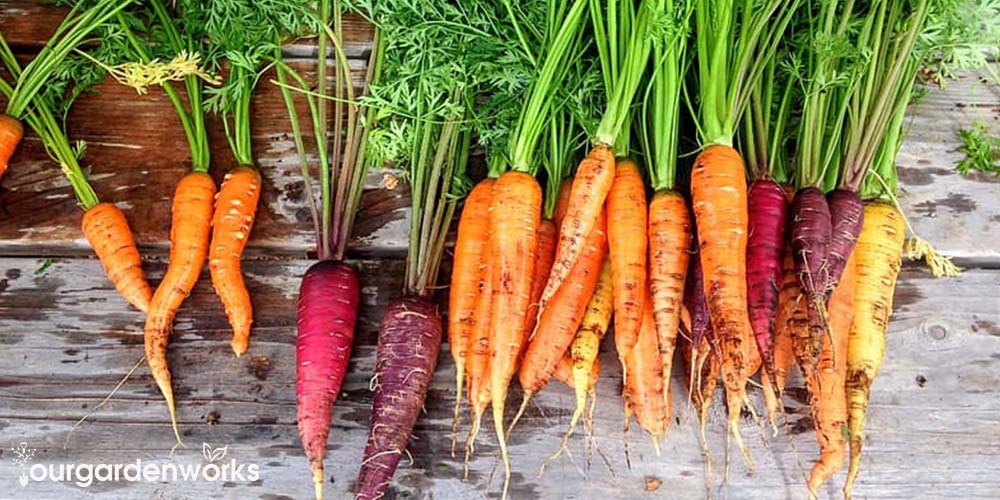Have you always wanted to grow your own vegetables? One of the reasons why we hesitate to do so is due to the lack of space. This is especially true when you live in apartment buildings or smaller spaces.
A practical solution to this is indoor gardening. It is basically growing plants inside a structure whether it is in your home, office, or even at your shop for a lot of reasons. It could be for practical reasons like producing your own food, for decor, or to augment the yield of your outdoor garden.
There’s plenty of vegetables you can grow indoors. This includes carrots. It is easily one of the most versatile and delicious vegetables around. What’s more, it is one of the easiest crops to grow even with just a little effort.
So, read more below to learn how to grow carrots indoors from seed.
What are Carrots?
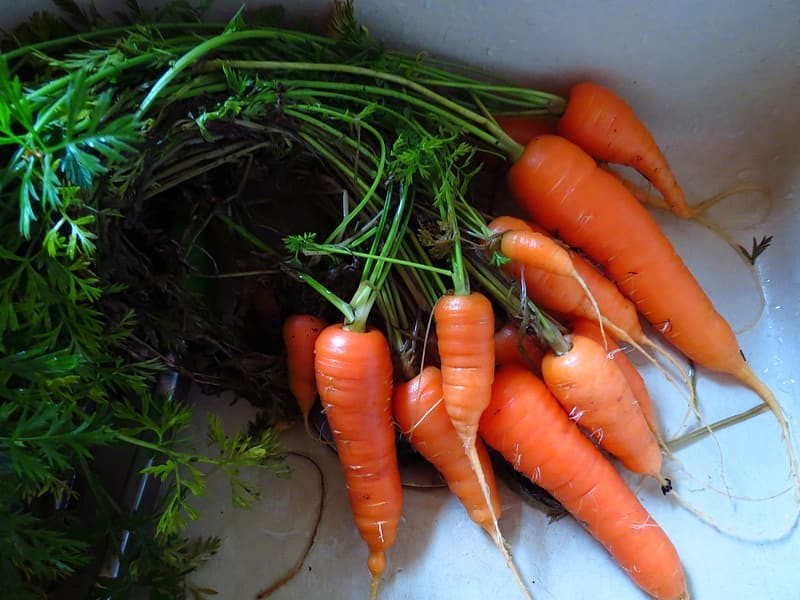
Carrots are root vegetables and are included in the Umbelliferae or Apiaceae type of plants. It is a plant family which mostly consists of fragrant and flowering plants. This includes parsnip, celery, parsley, cumin, anise, dill, and the like.
This root crop is rich in vitamins like vitamin A which helps in improving your vision. It also has minerals and antioxidants that fight off different illnesses like cancer and improve the overall condition of your body.
If you are curious about what other nutrients you can get from eating a single carrot, check the table below.
| Nutrient | Nutritional Value |
| Water | 53g |
| Energy | 24.6 kcal |
| Protein | 0.558g |
| Total lipid (fat) | 0.144g |
| Carbohydrate | 5.75g |
| Dietary Fiber | 1.68g |
| Sugar | 2.84g |
| Calcium | 19.8mg |
| Iron | 0.18mg |
| Magnesium | 7.2mg |
| Phosphorus | 21mg |
| Potassium | 192mg |
| Sodium | 41.4mg |
| Zinc | 0.144mg |
| Copper | 0.027mg |
| Selenium | 0.06µg |
| Vitamin C | 3.54mg |
| Thiamin | 0.04mg |
| Riboflavin | 0.035mg |
| Niacin | 0.59mg |
| Vitamin B-6 | 0.083mg |
| Folate | 11.4µg |
| Choline | 5.28mg |
| Vitamin A | 501µg |
| Beta Carotene | 4970µg |
| Alpha Carotene | 2090 µg |
| Lycopene | 0.6µg |
| Lutein + zeaxanthin | 154µg |
| Vitamin E | 0.396mg |
| Vitamin K | 7.92µg |
| Saturated Fatty acids | 0.019g |
| Monounsaturated Fatty acids | 0.007g |
| Polyunsaturated Fatty acids | 0.061g |
If you are curious about how much nutrients you can get per serving of carrots, you can visit the Department of Agriculture page for more information.
Where Did Carrots Come From?

About a thousand years ago, in 200 BC in a country now known as Afghanistan, people started growing carrots. Back then, sweet orange carrots did not exist yet.
The farmers from this period planted yellow, white, and purple varieties which usually tasted woody and bitter. Furthermore, it was used for medicine rather than as a staple vegetable.
It was only in the 16th century when Dutch farmers decided to genetically modify carrots to become sweeter and discovered the orange variety. By this time, carrots were only served in the royal courts and the homes of the rich.
Carrots were only cultivated in the 19th century and became available in any home.
Why Should You Grow Carrots Indoors?
Store-bought fruits and vegetables can never compare to the ones you grow yourself. In fact, there are plenty of advantages to growing your own food. You also get to choose the varieties you prefer.
Furthermore, you also get to control the kind and amount of fertilizers and pesticides you will use or you can even choose to not use any at all. Additionally, some vegetables have to be picked at the right time for the carrots to be more nutritious.
Some need to be harvested before they ripen while others have to be picked at the peak of being ripe. One example of this case is the carrot. Did you know that a fully grown carrot has more nutrients than one that was picked early?
Additionally, you can even have access to fresh produce even during winter. They will actually thrive more if you plant them in a pot. Another plus when you grow carrots indoors is that you have complete control of the temperature and moisture levels.
They also do not have to be subjected to external forces like rain, wind, and pests.
What Variety of Carrots Can I Grow Indoors?
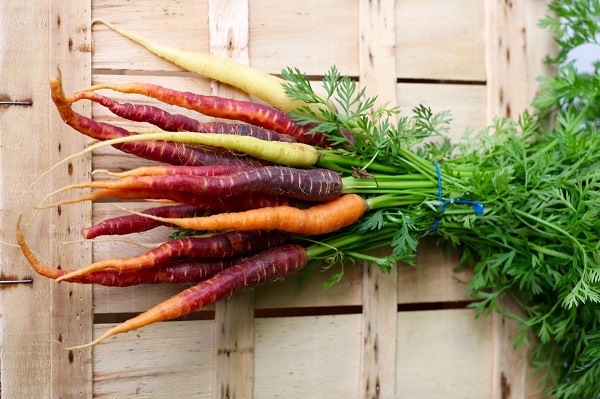
Many types of carrots that are cultivated and eaten today. Interestingly, they come in varying colors. However, shorter carrot varieties are best for growing indoors as they need lesser space to grow.
However, you can also choose to grow longer varieties as well. Just make sure to choose deeper containers to accommodate it.
Here are some carrot varieties that thrive indoors.
Short Carrot Varieties
1. Parisian Heirloom
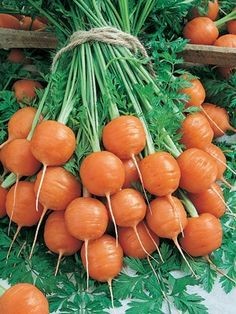
Characterized by its rounded shape, the Parisian Heirloom is a great choice for indoor gardening. Since they are smaller in size, you will only need shallow planters. Plus, heirloom varieties have more nutrition than newer varieties.
This variety thrives in rocky soil.
2. Danvers

Another heirloom variety, Danvers carrots stay crisp and are ideal for canning. They also grow well in shallow heavier soil like clay and loam. Danvers also has higher fiber content than other types.
3. Little Finger
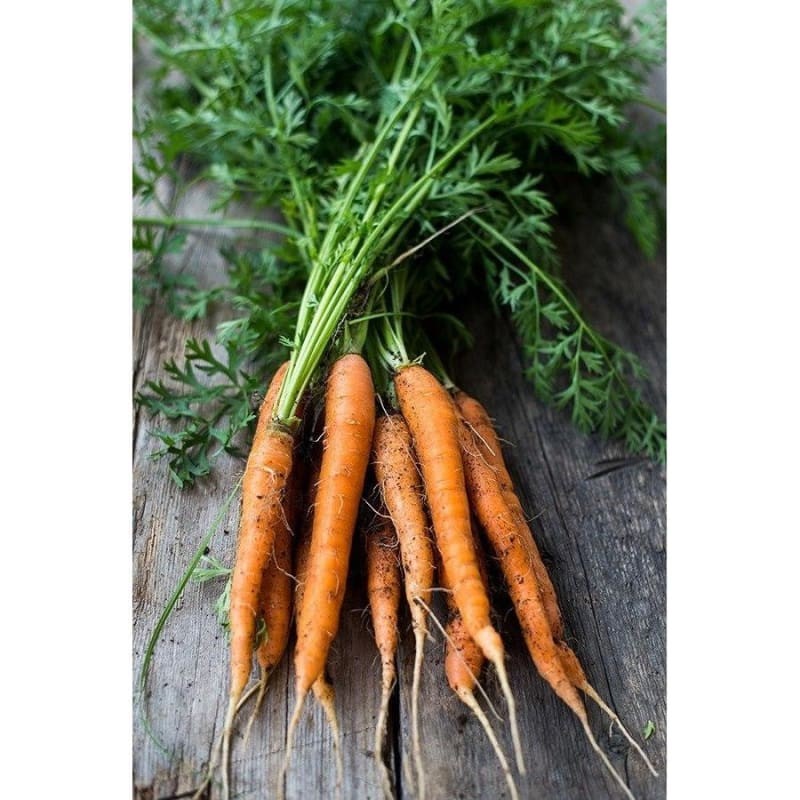
The Little Finger variety may be tiny compared to other carrot types but they are definitely sweet. It ripens earlier than other varieties and grows to the size of a finger upon maturity. This plant loves the sun, so choose the sunniest area in the room. A well irrigated and sandy soil works best with Little Fingers.
4. Red Core Chantenay
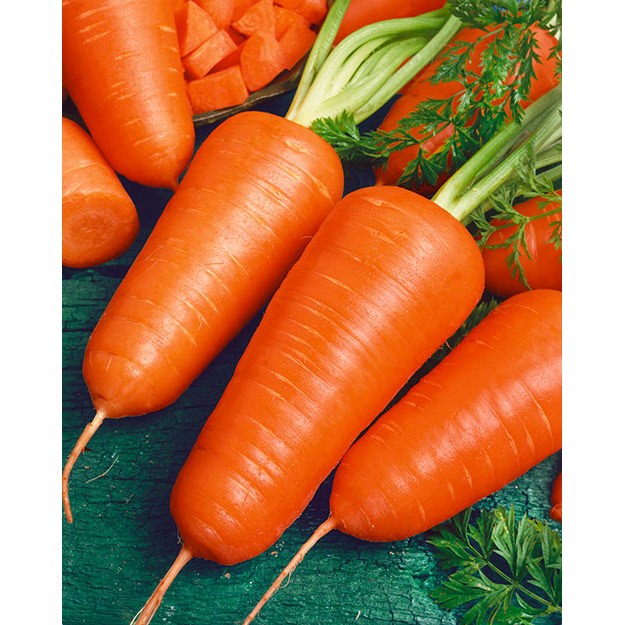
This heirloom variety will only need an 8-inch planter and is quite easy to grow. It is about five and a half inches long when it matures and also has a reddish core. Hence, the name Red Core Chantenay.
It needs well-worked soil without stones to grow well.
5. Royal Chantenay
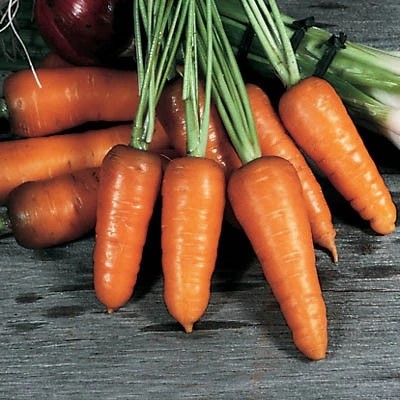
Another Chantenay variety in the list, the Royal Chantenay can grow five to seven inches in length and can be planted in heavy soil types. To easily distinguish it from the Red Core Chantenay, just remember that Red Cored Chantenay has a reddish core with a blunt tip.
Meanwhile, the Royal Chantenay has a more cylindrical shape, tapered tip, and a red-orange core.
6. Short N’ Sweet

The third Chantenay type in our list. Short N’ Sweet variety is sweet and can grow to four inches in length. It also has a bright orange core and was developed to grow in poor quality and heavier soil types.
Other Varieties That will Need Deeper Planters
1. Deep Purple

If you want to add other colors, the deep purple carrot is also a great choice for indoor planting. It grows up to eight inches in length. So, it is best to prepare a 12-inch deep planter.
It is also purple even on the inside even when cooked, unlike the purple dragon which has a reddish-orange core.
2. Lunar White
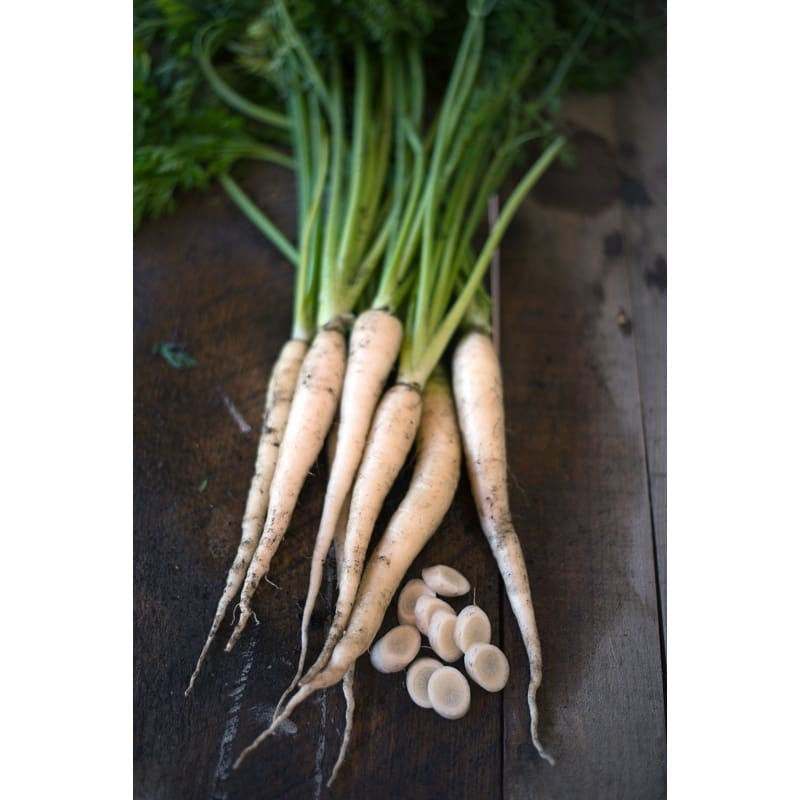
Having a mildly sweet flavor, the lunar white carrot can grow to about six inches and tapers at the tip. This white carrot is almost coreless but is still crisp. Lunar white prefers loose soil without stones.
However, if you plan on using heavier soil types like clay, make sure to cover it with mulch and to periodically weed it. This prevents the carrot from becoming green.
3. Kyoto Red Carrot

The Kyoto Red Carrot needs to be under the sun. You can place it in the sunniest area of the room or place it under a light lamp. This carrot is one of the longer varieties and can grow to 12 inches long.
When growing indoors, you will need a deeper pot with an acidic soil that is between 5.8 to 6.5 pH. Loosen the soil and to add to the acidity by mixing coffee grounds with compost.
4. Solar Yellow
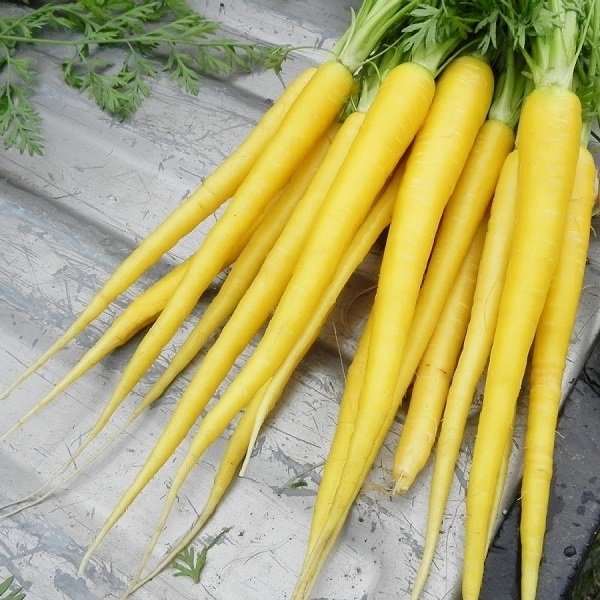
About six to seven inches in length upon maturity, the Solar Yellow carrot has an almost buttery color to it. It is quite crisp and tastes sweet. This heirloom variety will grow well in any type of soil as long as it is loose and well-irrigated.
If you are uncertain of which variety to start with, you can choose to buy a kaleidoscope carrot seed mix. It has different types of carrots in different colors.
How to Grow Carrots Indoors From Seed?
It’s finally time to start your indoor garden, here are the things that you will need.
Materials
- Planter or pot
- Soil
- Seeds
- Fertilizer or compost
- Water
- Tray to catch water/bottom plate
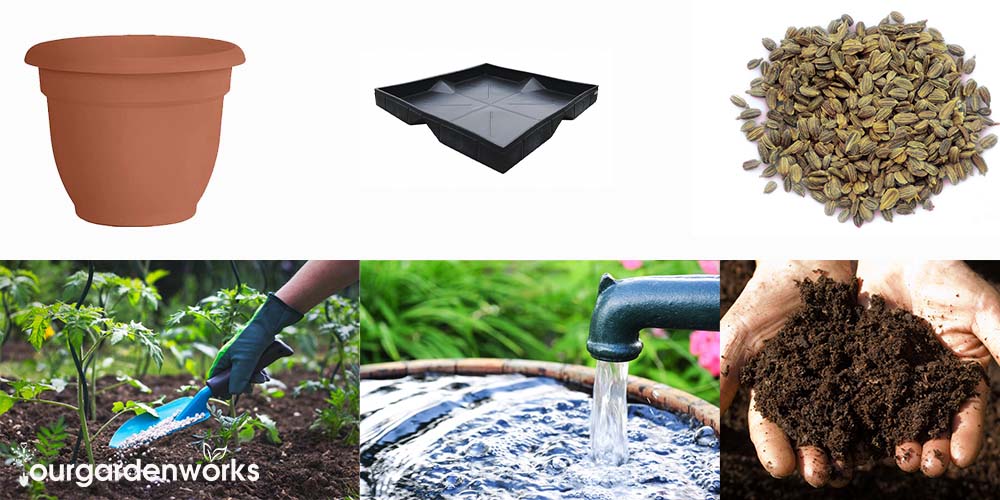
How To Do It?
A Step-by-Step to Grow Carrots Indoors From Seed
- Prepare the planter
The depth of your pot will depend on the type of carrot that you are going to plant. Let’s say, you are planting the shorter types, an 8-inch pot will be enough. However, if you are not sure of how long the root will grow, using a pot that can hold about 12 inches of soil is the safest option.
When you are done with that, place the planter or pot onto a tray. It should be deep enough to catch any excess water. - Pour in the soil
The next thing you have to do is pour in the soil which is either heavy or sandy. If you are unsure, you can mix sandy soil with mulch or organic compost. Make sure to loosen it to allow the carrot to grow.
Remember that garden soil is too heavy for most planters, this is the reason why you mix it with compost or mulch. After pouring the soil into the pot, be sure to leave at least an inch from the rim of the planter. - Plant the carrot seeds
Before pouring in the seeds, poke three holes that are about an eighth of an inch deep and 2 inches apart on the soil. This will prevent the carrots from overcrowding. After you’re done with that, place seeds in each hole.
Note that carrots have a low germination rate that some gardeners usually just sprinkle the seeds onto the pot directly. When the plant starts to grow, they remove the thinner stems to stop overcrowding the healthier crops.
Unlike other types of vegetables, such as the asparagus, sowing carrots in a larger pot at the onset is the usual practice. Since carrots do not transplant well and might die when moved from one planter to another. - Place in a sunny area
Since carrots need the sun, place it in an area of the room where it gets to bask in the sunlight for at least six hours. Doing so will help your carrots grow well.
- Keep the soil moist
As seedlings, carrots love moisture, so while they are growing, the soil should be well irrigated. However, they can also be susceptible to a fungi disease called the Pythium fungi.
When your carrot is afflicted with this, the roots will appear to have dark to black colored cavities all around it. It usually infects the plant early on in its development. So try not to overwater the plant.
Another method to prevent this is to water it with chamomile tea. Chamomile is a natural and mild anti-fungal agent. You can boil two packets of tea and it should be enough. You can also do a one-time dusting of charcoal or cinnamon on to the soil to prevent fungal growth. - Wait for it to grow
The last step is to wait for your seedlings to grow. Make sure to remove all the thinner stems. Depending on the variety, you will have to wait 60 to 80 days or two and a half months for the carrots to mature. You can also harvest earlier if you want baby carrots, instead.
When watering the plants after its seedling stage, the roots become a little more mature which is usually about two inches in length. An inch of water should be enough for a week. Although, you have to ensure that the soil is soaked through to the roots.
How To Harvest Carrots?
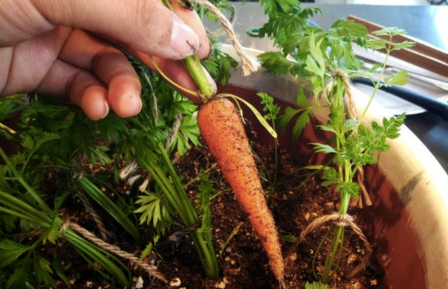
As mentioned before, it should take at least two and a half months before the carrots are ready to be harvested. If you want to eat baby carrots, you can harvest after 60 days. So, keep your seed packet for future use.
The time it takes for the plant to mature is usually stated at the back of your seed packet. Once you are sure that the carrots are mature enough, you can start harvesting.
Start by loosening the soil around the plant and slowly pulling it out. If you just directly pull on its leaves, the chances are you will only be pulling out its leaves.
Once you are done with that, cut off the leaves and leave out at least an inch or two of stem on the carrot to help keep it fresh longer. You also don’t have to harvest all of the carrots at one time.
For example, if you can only consume about three carrots in a week, you can choose to harvest only that amount and leave the rest. You can choose to delay the harvest of the other plants for about a week or even more in colder temperatures.
Final Thoughts
Although planting carrots indoors can be quite intimidating, you’ll find that after doing the first step, it’s actually easy to do indoor carrot gardening. What’s more, carrots are not the only vegetables you can plant in your home.
The tips above are designed to help you successfully harvest your first carrots. So, start growing carrots indoors now.
